A Matter of Disposal
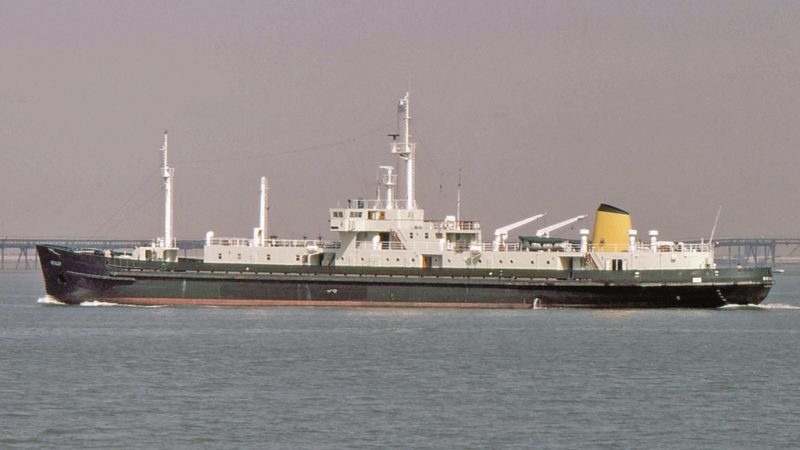
The term “Bovril Boat” disappeared from nautical glossaries in the mid-1980s. It was a humorous slang anecdote, used due to perceived similarity in color of their cargo to a well-known beverage, applicable to those vessels which were engaged in carrying human waste and sludge to designated spoil dumping grounds off major river estuaries, originating from estuarial cities such as Glasgow, Manchester via the Ship Canal, the Tyne, London, and Southampton, to name but a few. It is not commonly understood what an important service these vessels provided to large coastal cities. Rather than being mocked by virtue of their slang name, these little ships were engaged in a serious and highly regulated aspect of the shipping world, not always fully appreciated, for the seeming unmentionable role for which they were specifically intended, ie the safe and controlled removal of solid waste and dispose of it in specific locations offshore, always on an ebb tide. The requirement of waste disposal originated due to the introduction of flush toilets in the 1840s. In London this caused their ageing sewers to overflow and create a serious health hazard, including cholera epidemics. Although this forced the redesign and improvement of the sewage systems it did not totally resolve the issues and was only partially satisfactory, as the sludge part of the human waste sewage began to build up on mud banks further downstream, on the rivers where large cities were situated.
The seriousness of the problem was aggravated when, in 1878, a passenger steamship, The Princess Alice, sank at Gallions Reach, on the River Thames, following a collision with a cargo vessel, with great loss of life. Many of the dead recovered from the water were found not to have drowned but rather had died from swallowing significant quantities of toxic human sludge-filled, river water. The public outcry from this incident triggered a Royal Commission to be convened in 1882, to review the matters applicable to human waste and sludge disposal. The Commission concluded that it was necessary to create cleaner rivers by separating the sludge part from the liquid sewage and remove it via ship, for disposal out at sea. As a result, the first ship of a long line of ‘pump and dump’ effluent tanker vessels was launched in 1887. These ships, later nicknamed by those who crewed them as “Bovril Boats” to describe their brown liquid cargo. These ships were superbly maintained, operated as hygienically as was possible, and specially designed for the management of liquid marine waste disposal functions. This concept of toxic human waste was quickly followed throughout the United Kingdom. The sludge carrier vessel Bexley (above) of 2,175 grt was built in 1966, built by Caledon Shipbuilding & Engineering Co. Ltd., Dundee for Greater London Council. She was used exclusively for carrying sludge to the ‘Black Deep’ disposal grounds in the River Thames estuary. She was powered by a twin-screw 2 x six-cylinder, four-stroke Ruston & Hornsby ATCM6 of 2,480 bhp. She had a service speed of 12 knots. In 1974 her ownership was transferred to the Thames Water Authority. In 1990 Thames Water Authority was privatised and re-incarnated as Thames Water Utilities Ltd. In 1999, after sludge-dumping was banned due to pressure from environmentalist groups, she was sold to Madeleine Maritime, Panama, name unchanged, under the Honduras flag. In 2001 she was sold for demolition by Indian breakers arriving at Mumbai on 27th August of that year.
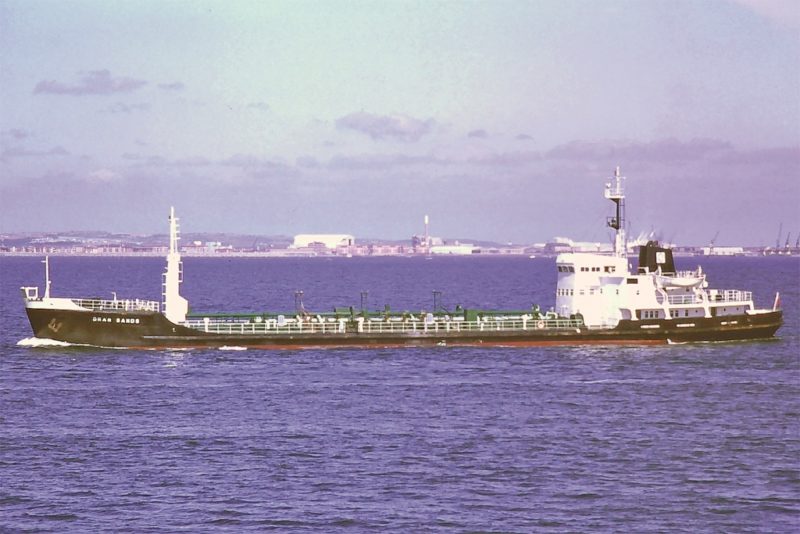
In the 1990s, due to pressures from environmentalists, European Union legislation was introduced forbidding the dumping of raw sewage at sea, and also due to increasing public concerns that sewage was contaminating beaches, led to the phasing out of these disposal vessels, most were scrapped or sold on to private companies for use outside the European Union, since newer waste management technology had allowed the sludge to be incinerated in self powering incinerators, which turned the waste into fertilizers.
The steamship Shieldhall is a heritage steamship based in Southampton. She was built by the Lobnitz shipyard at Renfrew in 1955 and served as a Glasgow Corporation River Clyde “Bovril Boat”, carrying treated sludge to the dumping grounds situated to the south of the Isle of Bute. She also continued a long tradition, dating back to the First World War, when Glasgow’s sludge vessels offered disadvantaged families, and wounded or disabled ex-service personnel, free day trips down the river in the summer months. This meant that Shieldhall was built with a large saloon and facilities to accommodate up to 80 day-passengers on trips down the Clyde, and which now act as an important facility in its current role.

Now preserved and used in the role of a mobile museum and historic vessel owned by the Solent Steam Packet Ltd. and operated under a registered charity the “Steamship Shieldhall Charity”, run by a team of dedicated volunteers. The volunteers also crew the ship for excursions to near coastal places and areas of interest. The Heritage Lottery Fund have also provided support for several projects including restoration of the saloon. This vessel is the largest remaining working steamship in Great Britain.
In 1976, after more than 20 years of service on the Clyde, the Shieldhall was laid up and was subsequently purchased by the Southern Water Authority in 1977. After some modification, she carried sludge from Marchwood, Millbrook, and Woolston in Southampton to a dumping area south of the Isle of Wight for five years between 1980-1985. Rising fuel prices and operating costs eventually led to her being withdrawn from service and laid up in July 1985.
Her steam propulsion system and many features from an earlier era led to the interest of active preservation being considered. Consequently, the Southampton City Museum Services, a preservation society, was formed with the aim of acquiring and preserving and restoring the ship to an operational standard. Hence, Shieldhall was purchased from Southern Water in 1988, for £20,000, which represented her scrap value. Solent Steam Packet Ltd. was formed and registered as an Industrial and Provident Society to own, preserve, and operate the ship. Solent Steam Packet later became a Community Benefit Society and in 2020 a registered charity was established to take over responsibility for all aspects of preserving and operating the ship, which included fundraising and day to day management, while ownership remained with Solent Steam Packet Ltd.
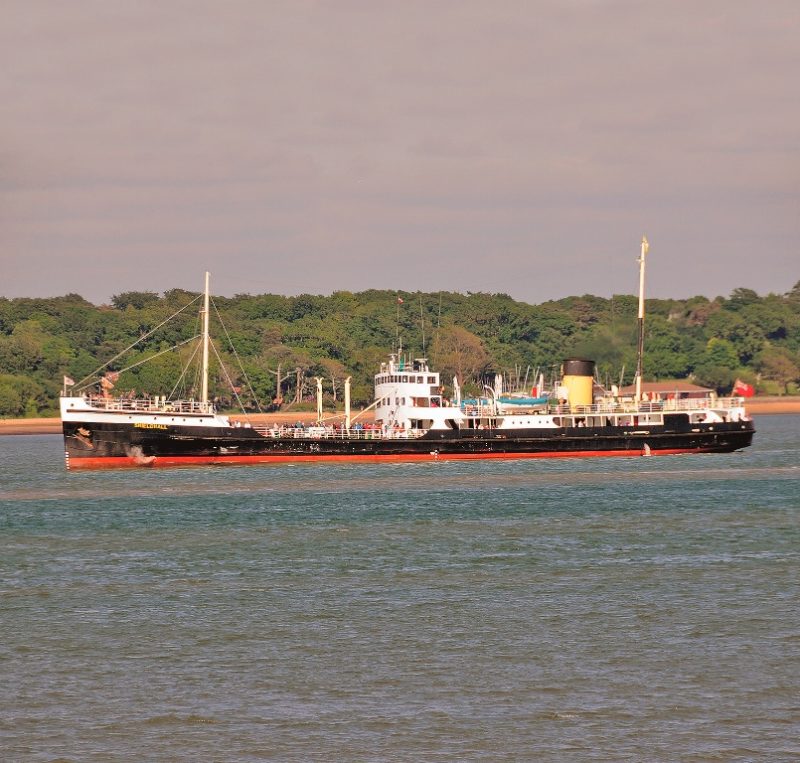
Shieldhall is now a frequent sight around the Solent providing excursions for passengers to enjoy trips on an historic steamship. Passengers are also given the opportunity to visit working areas such as the navigation bridge and the engine and machinery spaces. On occasions she has also ventured further afield having been back to her home port of Glasgow and to Holland for the Dordrecht Steam Festival. She has also been an attendee at each of the International Festivals of the Sea at Bristol and Portsmouth.
A more recent photograph (left) of this old lady of the sea. A wonderful gesture “THANK YOU NHS” painted on the side of the Shieldhall in recognition of the outstanding contribution made by the National Health Service during the recent COVID pandemic.
Operations of the vessel was suspended during the Covid-19 crisis but excursions to the Needles at the head of the Solent and the Nab Tower, located at the eastern extremities of the Solent, resumed in Summer 2021.

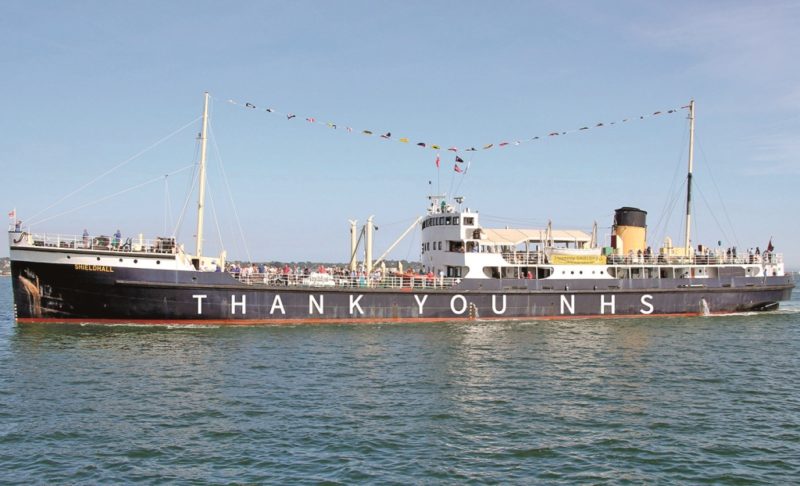
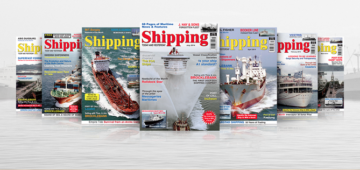


Comments
Sorry, comments are closed for this item